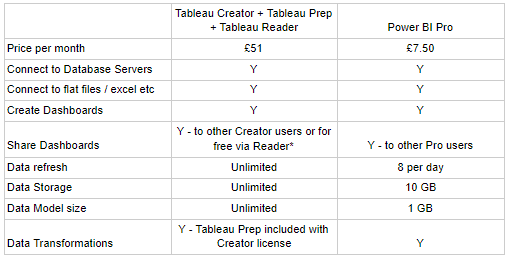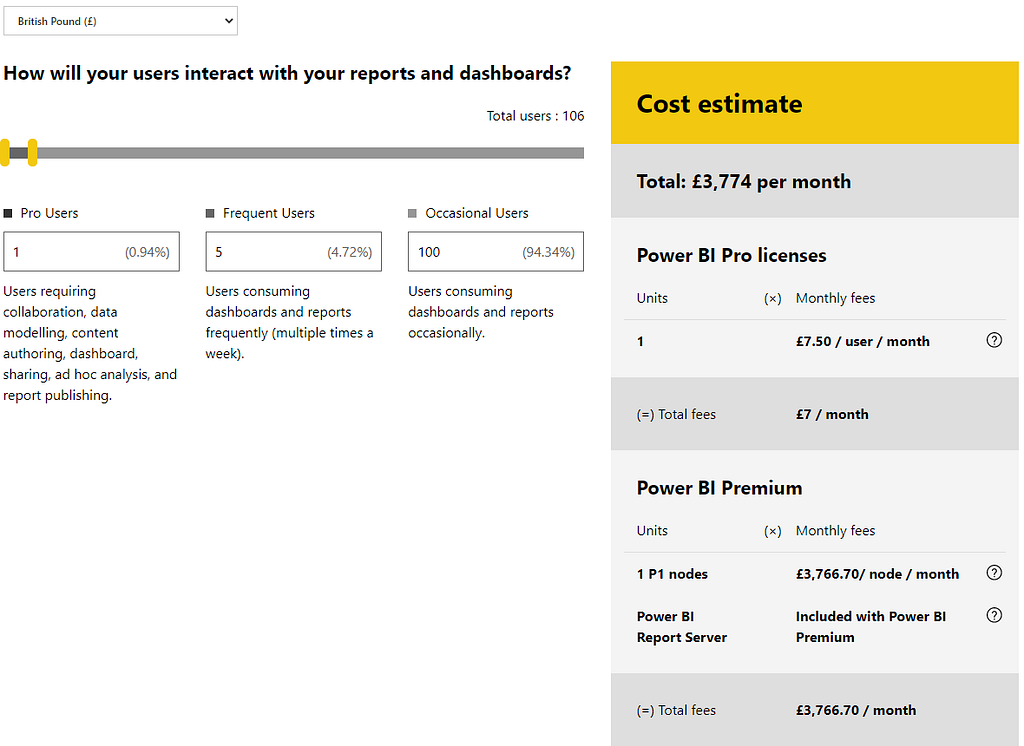Data Visualisation 2021 Blog Series Part 1 — Tableau vs Power BI
There are loads of tools offering a Data Visualisation solution but two have stood out for many years as market leaders: Power BI and Tableau. Tableau was the original “modern day” visualisation tool, while Microsoft has quickly closed the gap with Power BI.
In this, the first of a 3 part blog series, we will look at high level features in both Tableau and Power BI, plus associated costs. The second in the series will go into the tools in more detail, highlighting the advantages and disadvantages of each. The final blog in the series will wrap up, as well as provide some additional thoughts on what should be taken into consideration when embarking on Data Visualisation.
Let’s start by comparing the various plans.
Free Version

Paid Version

*You can still download Tableau Reader, but a word of caution: it should not replace an enterprise solution like Tableau Server or Tableau Online. This is due to the lack of data governance surrounding Tableau Reader, as it relies on physical files, and you can not keep track of who can open and see data. Only use Tableau Reader with very limited, trusted users who do not need a full Creator license.
Enterprise
This is where things get complicated. With Enterprise, you get a much more rounded solution from both providers which gives you the ability to share content to the masses with the proper security / data governance.
Firstly, let’s look at what each company advertises as their enterprise options.
Tableau:

These are the “rack rates” advertised by Tableau. Tableau can make big commercial discounts that can make a big difference. It is worth contacting a sales representative from Tableau to see what you can get, especially if you are a non-profit / public sector organisation.
If Tableau is hosting, this is via a service called “Tableau Online”. The alternative is “Tableau Server” which is on-premise / public cloud where you need to take care of the maintenance of the servers / service. This means there will be additional infrastructure / personnel costs.
Both of the Tableau Enterprise options have a minimum number of users:
- At least 1 Creator
- At least 5 Explorers
- At least 100 viewers
Using this number of users, Tableau will cost the following:
For you to host — £1056.95 (plus the infrastructure and personnel cost of hosting)
For Tableau to host — £1283.55
Power BI:
Premium is what Microsoft calls their Enterprise product, which gives you a Power BI Reporting Server license.
The licence is capacity based, so there is no limit on users but the infrastructure needs to be monitored to ensure it can handle the number of users. To increase capacity on the infrastructure will then incur a bigger charge.
So per node, per month, premium costs a whopping £3,766.70. Power BI does not offer a hosting service, so you need to add to this cost the price of infrastructure and personnel for hosting.
For this price, you also get:
- 100 TB data capacity limit
- 10 GB data model limit
- 48 data refreshes per day
Power BI provides an online calculator, let’s put that to the test using the same number of users in the Tableau example, 106 in total.

For argument’s sake, I have translated the split of users from Tableau’s Creator (1) / Explorer (5) / Viewer (100) to Power BI’s Pro (1) / Frequent (5) / Occasional (100). This is not entirely accurate, as Explorers on Tableau can still create content via Web Edit, whereas it seems a frequent user cannot for Power BI (i.e. would need a pro license) but let’s go with it.
For the same number of users, Power BI’s calculator says we will need one node, which comes to a total (including the pro license) of £3,774 plus cost of infrastructure and personnel to host.
To summarise:

You can have 106 Power BI Pro users for a lot cheaper than that (£795), you obviously don’t get the security and governance that comes with the Enterprise, or the extra data capacity / data refreshes, but all 106 of those people will be able to create and share content.
For Premium to become financially sensible, you need to have more than 502 Power BI users.
So let’s run the costs again for that number of users adding all the new users as Viewers / Occasional types.

Obviously these figures are very crude, but give a good sense as to the complicated nature of pricing. Something else to consider is the scalability of this pricing. With Tableau Online, you do not need to invest / get tied in as you do not need to invest in infrastructure or personnel for hosting, you are just paying the subscription for each user. With Power BI Premium, you have to get the right people in place, with the right infrastructure and commit to at least £3,774.
Let’s forget about price for the moment and look into the tools in more detail in part 2 of the blog series.

